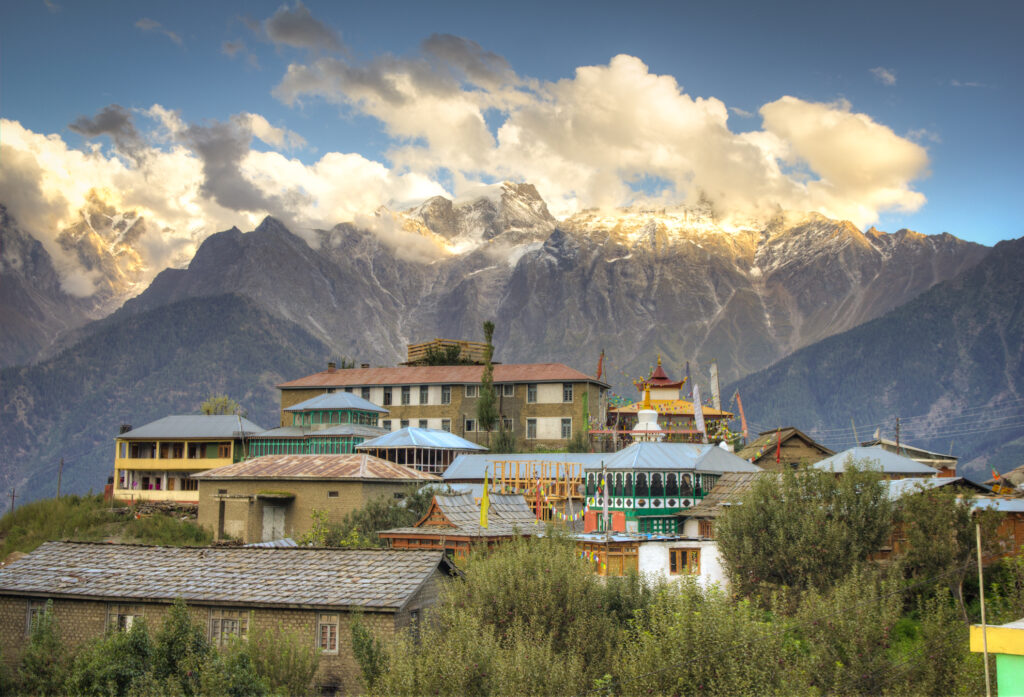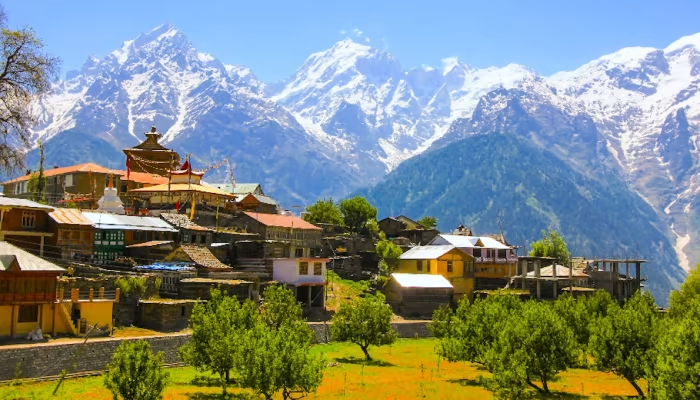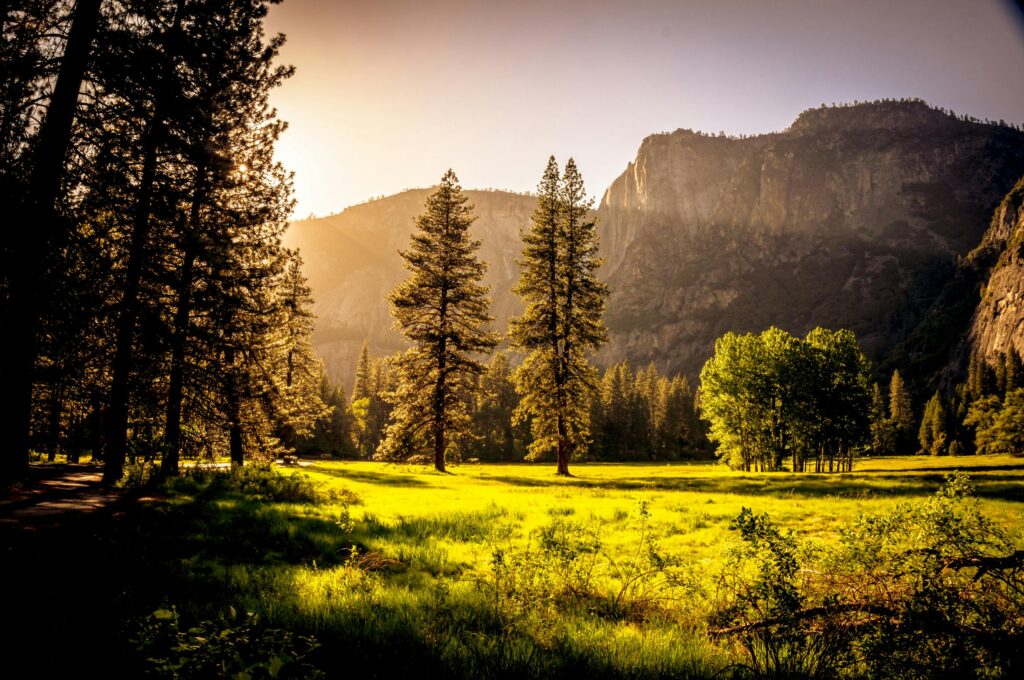
Hidden deep in the folds of Himachal Pradesh’s majestic Kinnaur district lies a village that feels untouched by time . Cradled at an altitude of nearly 3,000 meters, Kalpa offers jaw-dropping views of the Kinnaur Kailash range, traditional wooden homes, whispering pine forests, and a calmness that city dwellers can only dream of.
While tourists rush to Shimla and Manali, remains a peaceful retreat, waiting to enchant the thoughtful traveler. Whether you’re a nature lover, a seeker of silence, or someone looking to experience the raw charm of Himachal, it delivers — with snow-capped grandeur and heartfelt hospitality.
In this blog by Wander Vistas, we take you through a complete guide — what to see, where to stay, what to eat, and why this hidden Himalayan gem deserves a spot on your 2025 bucket list.
📍 Where is Kalpa?
Kalpa is located in Kinnaur district, about 225 km from Shimla, and just 7 km above the district headquarters of Reckong Peo. Positioned along the old Hindustan-Tibet road, Kalpa is often a stop for those venturing towards Spiti, but very few stay long enough to experience its quiet magic.
The star attraction? The Kinnaur Kailash range, which dominates the skyline and changes colors dramatically through the day. The sacred Shivling rock formation on the mountain is believed to be over 79 feet high and holds immense religious significance.
🛣️ How to Reach Kalpa
Getting to Kalpa is part of the adventure — winding roads, deep gorges, and dramatic landscapes await.
- By Road: From Shimla, it is about 8–10 hours by car via NH5. The route goes through Kufri, Narkanda, Rampur, and Reckong Peo.
- By Bus: HRTC buses run regularly from Shimla to Reckong Peo. From there, you can take a taxi or local bus.
- Nearest Airport: Jubbarhatti Airport in Shimla (about 250 km away).
- Nearest Railway Station: Shimla (connected via narrow-gauge toy train from Kalka).
📝 Tip: Roads can be tricky during monsoons and heavy snowfall, so always check weather updates before planning your trip.
🌤️ Best Time to Visit.
It offers a different experience each season:
- Spring/Summer (March to June): Pleasant weather and blooming apple orchards — ideal for sightseeing.
- Monsoon (July to September): Lush greenery but risky due to landslides.
- Autumn (October to November): Crisp air, colorful landscapes, and crystal-clear views.
- Winter (December to February): A snowy wonderland — perfect for snow lovers, but prepare for road closures and sub-zero temperatures.
If you want a mix of accessibility and beauty, April to June is the best time to visit.
🏔️ Top Things to Do
1. Watch the Sunrise Over Kinnaur Kailash
One of the most unforgettable experiences is watching the first golden rays hit the Kinnaur Kailash peaks. The snow glows pink, then gold, then white — a natural light show that leaves most visitors speechless.
2. Visit Suicide Point
Despite its grim name, this cliff-side viewpoint offers breathtaking vistas of deep valleys and sharp rock faces. The drop is dizzying, and the landscape is hauntingly beautiful.
3. Stroll Through Roghi Village
Just a couple of kilometers away, Roghi Village offers a glimpse into traditional Kinnauri life. Wooden homes, prayer flags, apple orchards, and friendly locals make it worth the short walk or drive.
4. Explore Narayan-Nagini Temple
This ancient temple is a great place to admire the local Himachali and Tibetan architectural fusion. The peace you’ll feel here is unmatched.
5. Try the Chaka Meadows Trek
For adventure lovers, this moderate trek takes you to the Chaka Meadows (~15,000 ft) above Kalpa. Expect stunning panoramic views and a trail lined with alpine vegetation.
🏡 Where to Stay in Kalpa
Kalpa offers a variety of stays — from budget homestays to comfortable boutique hotels:
🛏 Budget Options
- Hotel Rolling Rang
- The Monk Kalpa
- Hotel Apple Pie
🛏 Mid-range Options
- Echor – The Alpine Crest
- Hotel White Nest
- Hotel Kalpa Deshang
🛏 Homestays (Local Experience)
- Kalpa Homestay
- Kharka Homestay
- Duggi House
💡 Travel Tip: Book in advance during peak summer and autumn seasons. Many stays also include meals, giving you a chance to taste local Himachali cuisine.
🍴 What to Eat in Kalpa
Kalpa doesn’t have a bustling café culture like Manali, but it makes up for it with soulful food and warm service.
Must-Try Local Dishes:
- Siddu – Steamed wheat bun filled with spiced paste.
- Thukpa – A warm Tibetan noodle soup.
- Chha Gosht – A Himachali lamb curry cooked in yogurt and spices.
- Tibetan Butter Tea – Salty, creamy, and great in cold weather.
Also, don’t miss:
- Fresh apples from the orchards
- Homemade jams and pickles
- Chilgoza (pine nuts) sold locally
🛍️ What to Shop
While Kalpa is more about natural beauty than markets, you can still pick up:
- Hand-woven woolen shawls
- Kinnauri caps and stoles
- Dry fruits and apples
- Prayer wheels, flags, and Tibetan handicrafts
Reckong Peo has a slightly bigger market for essentials and souvenirs.
🙏 Culture and People
Kalpa is home to a mix of Hindu and Buddhist traditions, and the locals are known for their hospitality. Most people speak Hindi and Kinnauri, and a few understand English.
The wooden temples, prayer wheels, and monasteries reflect the spiritual fabric of the region.
💬 Always greet locals with a smile and a respectful “Namaste.” It goes a long way in the mountains.
⚠️ Important Travel Tips
- Altitude: At nearly 3,000 meters, Kalpa may cause mild altitude sickness. Stay hydrated and avoid overexertion.
- Connectivity: BSNL and Jio work best. Internet is slow but usable.
- ATM/Cash: Carry sufficient cash. Few ATMs and limited card acceptance.
- Driving: Roads are narrow and winding. Drive carefully or hire a local driver.
- Respect Nature: Don’t litter, and avoid playing loud music. Kalpa is about peace.
❤️ Final Thoughts: Why Kalpa is Worth Visiting
In an age of over-tourism and fast-paced travel, Kalpa offers the luxury of slowness. Here, the mountains aren’t just backdrops — they’re companions. The air is crisp, the apples are sweeter, and the silence is therapeutic.
It’s not just a place to visit. Kalpa is a place to feel.
So pack your warmest jacket, carry a book or two, and head to this Himalayan village where time stands still. And when you do — let Wander Vistas guide your way.

